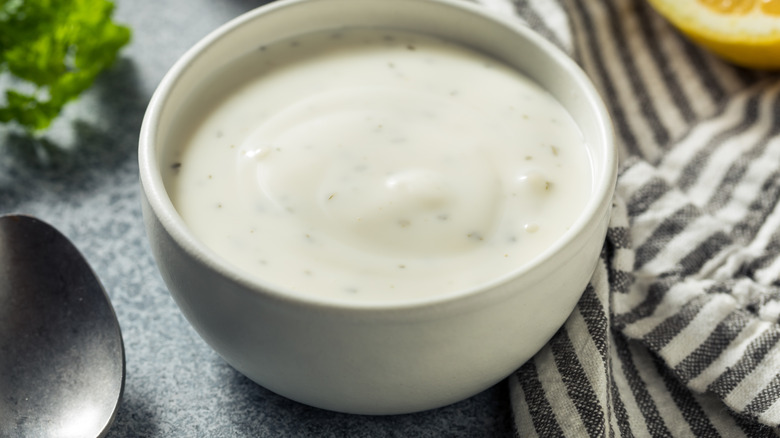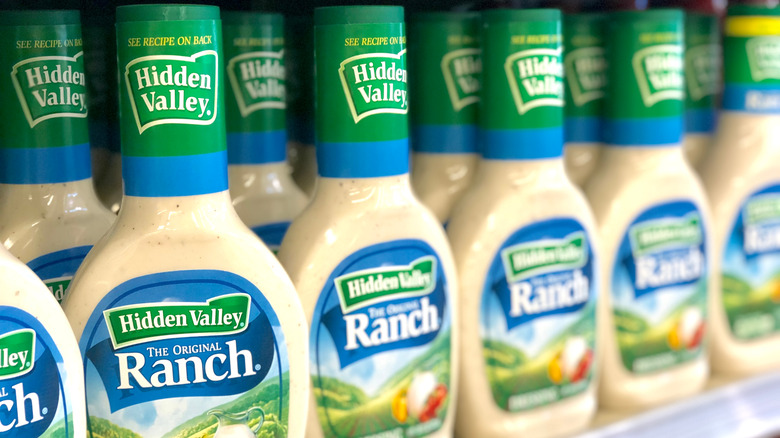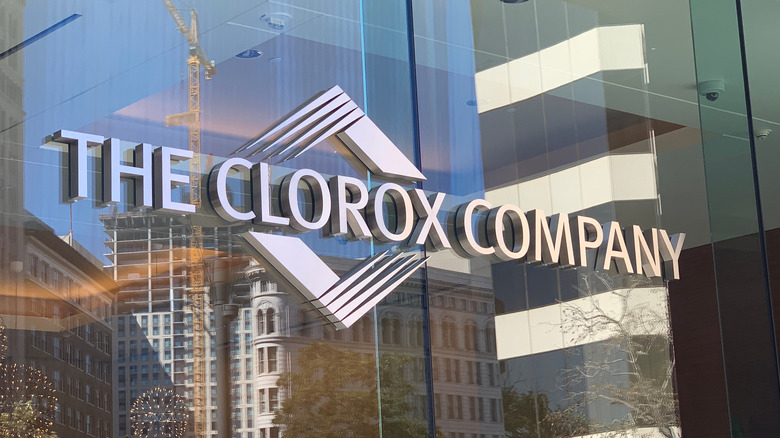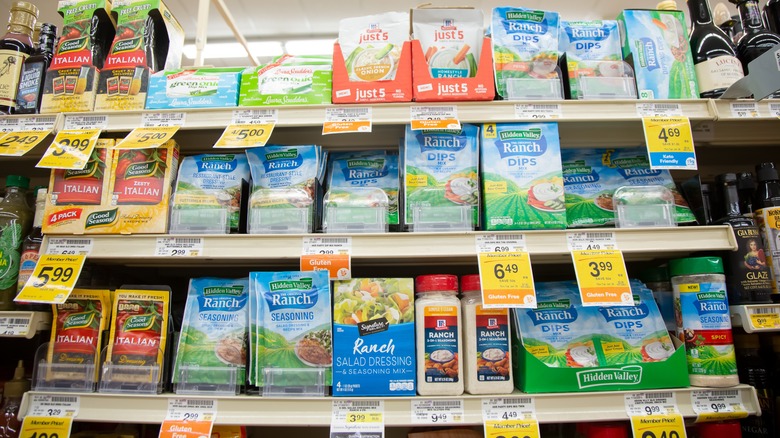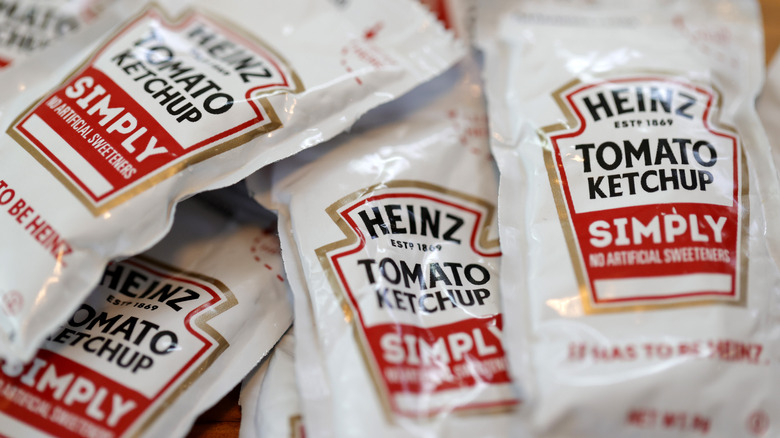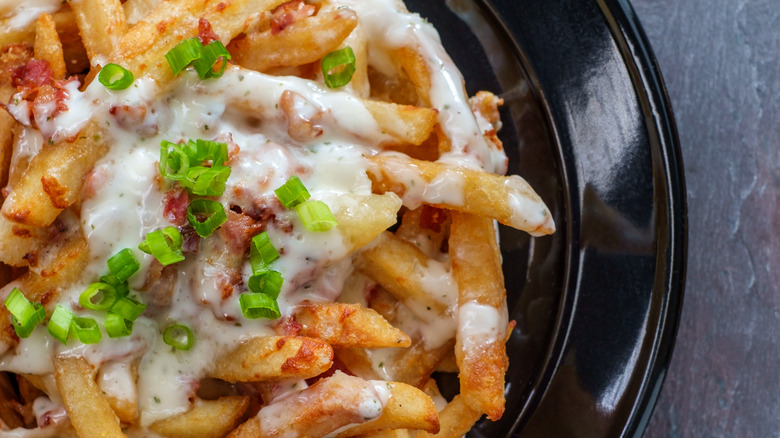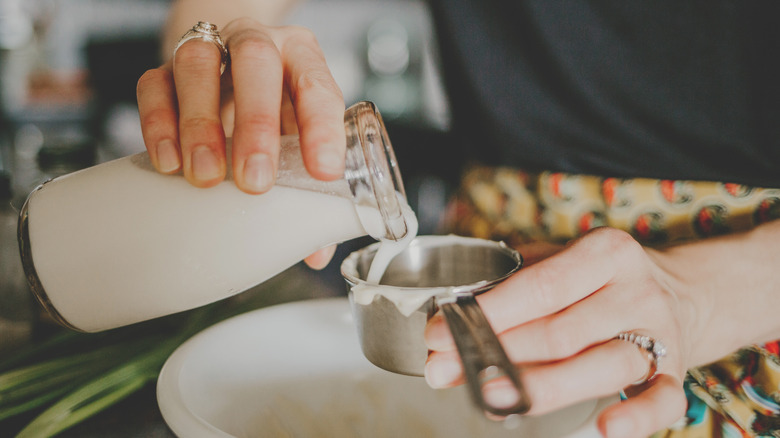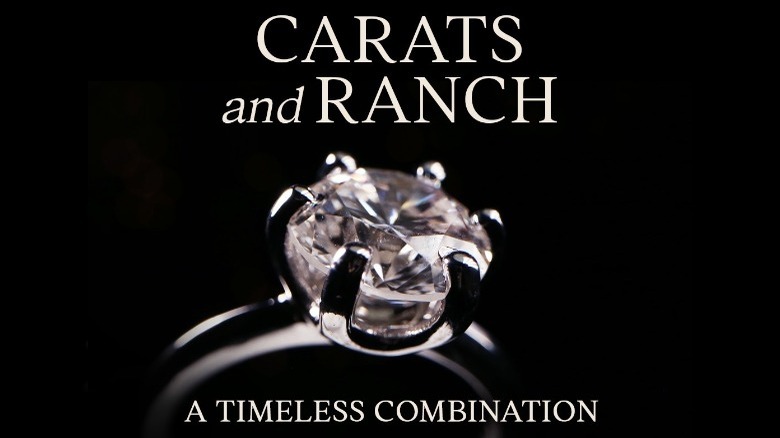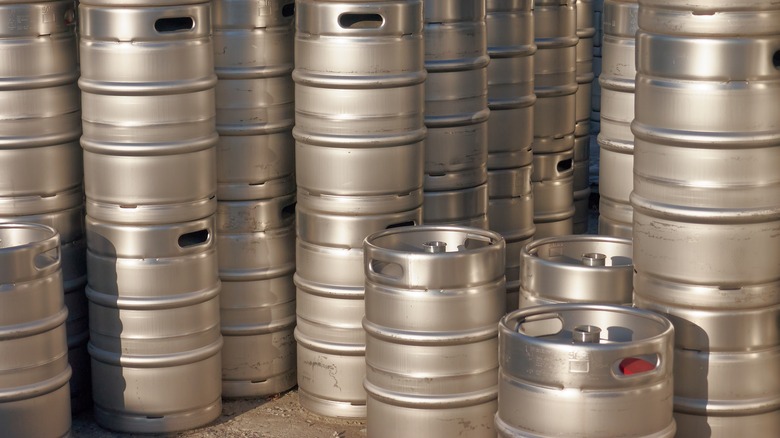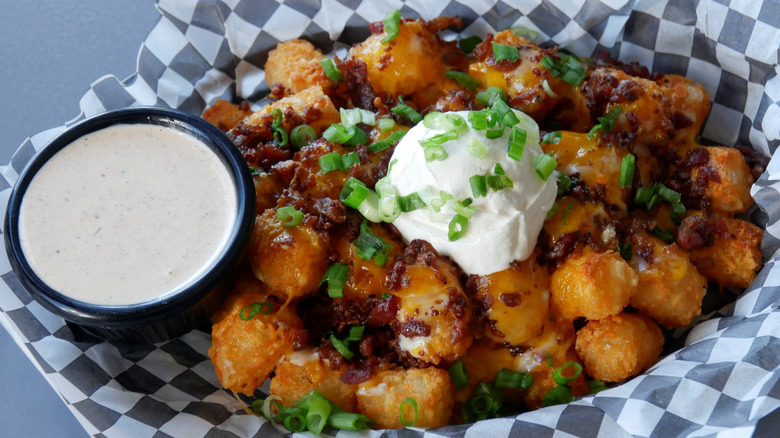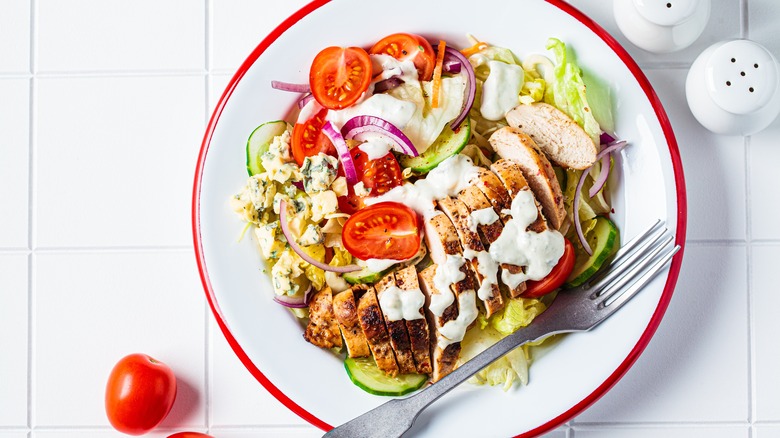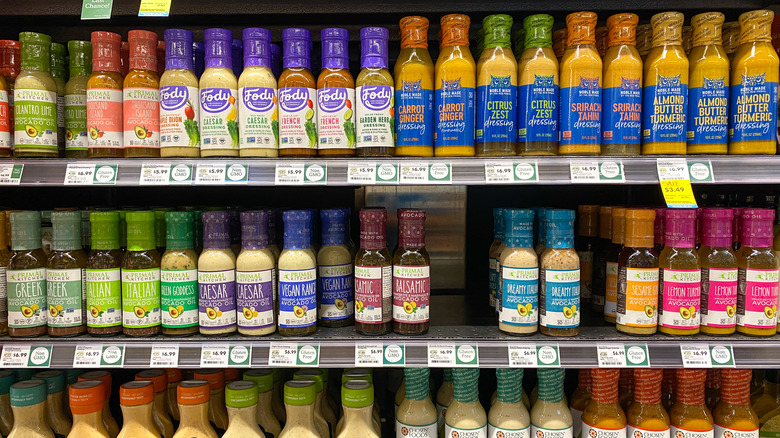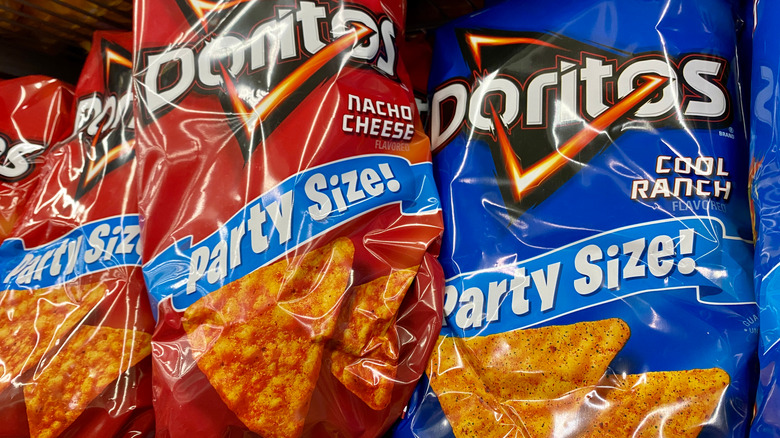The Ultimate Guide To Ranch Dressing
When it comes to food, if you say the word "ranch," everyone likely knows what you mean — there's no need to tack on "dressing" at the end. The unmistakable creamy, white salad dressing has become ingrained in popular American culture. It's no longer limited to just salads or carrot sticks anymore, as ranch dressing can also be found alongside pizza and chicken strips. Ranch-flavored dust is sprinkled on Doritos and other snack foods to give them a kick. A vegan form of ranch dressing is even available, and, according to an article in The New York Times Magazine, it rivals the original.
As ubiquitous as ranch dressing is, how much do you really know about it? Sure, you likely have a bottle (or two) in your fridge, and you know it's available at your favorite restaurants. However, do you know its origins or its secrets? If not, here's everything you need to know about ranch dressing.
Hidden Valley is a real place
Not only is Hidden Valley known as one of the most popular brands of ranch dressing today, but it is also the source of the good stuff. Yes, Hidden Valley is a real place on the map, and it's where it all started — or at least where things got serious.
According to Edible Alaska, the creator of ranch dressing, Steve Henson, worked in Alaska in the 1940s. In addition to being a plumbing contractor, he also cooked for his crew while they were working in the remote bush. In an interview with the LA Times (via Edible Alaska), he explained that he was looking for a way to make his vegetables a little more appealing to keep his crew happy. He experimented with various spices and herbs and mixed them with buttermilk and mayonnaise to create the first ranch dressing. He knew he was on to something when his recipe was a hit with his workers.
In 1954, Henson and his wife moved to California and bought Sweetwater Ranch, and he changed the name to Hidden Valley Ranch. The couple began serving food at the ranch, and a side of ranch dressing accompanied each dish. In fact, the dressing became so sought-after that Henson began selling envelopes of the mix in powder form across the country. Eventually, demand became so great that he shut down the ranch and focused on selling dressing full-time (via Thrillist).
The Clorox Company owns Hidden Valley
Ranch dressing had become so popular by the early 70s that the production facilities had to move from Henson's home to San Jose to keep up with demand (per The Santa Barbara Independent). The new facility produced 35,000 packages of dressing every eight hours. In 1972, Steven Henson decided to cash in and sold his business to Clorox for $8 million, as noted by Thrillist.
While Clorox continued to sell the original dry ranch mix that made Hidden Valley famous, it also expanded the line to include other varieties of dressing mixes as well, such as creamy Italian and thousand island (per The Clorox Company). In 1983, the company's first shelf-stable bottled salad dressing hit the market and quickly rose in popularity (per Thrillist). Enjoying the creamy and savory dressing was suddenly as easy as opening a bottle and pouring out a few dollops. In the late 80s, the company released a variety of dry dip mixes under the Hidden Valley Ranch brand.
Ranch goes mainstream
According to Slate, ranch dressing's popularity took off after Clorox began selling it in shelf-stable, pre-mixed bottles. The convenience factor was a game changer for home cooks and professional chefs alike. The rich and savory condiment began showing up in restaurants and fast-food chains across the country. Packets of ranch dressing were soon available for salads from McDonald's and Little Caesars.
In the mid-to-late 1980s, some restaurants also began using ranch dressing in place of mayonnaise, oil, and vinegar on sandwiches. The dressing is thinner than mayo, adds extra flavor, and doesn't make the bread soggy like oil and vinegar would, per Slate.
When wraps became popular in the 90s, ranch dressing showed up as a key ingredient in KFC's Twisters. At the same time, it was featured in dishes from Applebee's and Chili's. Snack foods were also drawn into the ranch craze, with Frito-Lay introducing Cool Ranch Doritos and Hidden Valley Ranch Wavy Lay's chips.
Is ranch the new ketchup?
Conquering the worlds of dry mix packets, shelf-stable salad dressings, restaurants, and even snack foods wasn't enough for the Hidden Valley brand. After Hidden Valley had taken on all of these and, arguably, won in just a few short decades of existence, it was time to take on the one condiment that may be more popular than ranch dressing: ketchup.
In the early 2010s, Hidden Valley released a new product called Hidden Valley for Everything Topping & Dip. The label, as Daily Mail reported, was emblazoned with the tagline, "The New Ketchup." David Kargas, a spokesman for Clorox Company, noted that the new product had the same consistency and use of ketchup. It was also packaged in the same kind of squirt bottle, which made adding it to your plate of fries or topping your pizza an easy task. So, how did this product launch work out for Hidden Valley? While the product did get some attention when it premiered (even garnering a sketch on "Saturday Night Live"), you can't find it in grocery stores today.
Ranch retains its popularity with new generations
New generations are blamed for killing off many industries that once reigned. In 2018, millennials were partly responsible for the decline in American cheese, beer, canned tuna, and mayonnaise. However, in an article for Ad Age, Jack Neff assures us that ranch is not going anywhere and even named the dressing the "condiment of choice" for both millennials and Gen Z.
While ranch dressing started out as a topping for salads, it is now found on all types of foods, such as popcorn, pizza, and fries. It has even overtaken blue cheese as the preferred dipping sauce for chicken wings. As ketchup sales have remained flat in recent years, ranch sales show growth, per Ad Age.
Ranch has become so popular in recent years that it even has its own fan base. Loyal consumers even celebrate National Ranch Day each year on March 10 (via Kidadl).
As reported by Ad Age, ranch dressing can be found in 75% of homes in the U.S. and on more than half the country's restaurant menus. In other words, ranch dressing is here to stay.
What is ranch dressing?
You know ranch dressing is popular, but what is it? While the dressing can be made in a variety of ways, in order for it to be considered authentic, you need three main ingredients: buttermilk, mayonnaise, and herbs and spices, per SFGate.
The original recipe called for full-fat buttermilk; however, for those concerned about fat content, low-fat buttermilk may be used instead. The key here is that buttermilk is required for that authentic taste.
Mayonnaise is a crucial ingredient in ranch dressing as it gives it its recognizable texture. While some dressings swap out yogurt or vinegar in place of mayonnaise, ranch dressing needs the mayo in order to achieve the proper texture.
Herbs and spices are the final ingredients necessary to make authentic-tasting ranch dressing. Black pepper, thyme, garlic powder, parsley, onion powder, and MSG were likely used in the dressing's original recipe.
Home and professional chefs have now created a variety of recipes for ranch dressing. In addition to the main components, some recipes include vinegar, lemon juice, chives, and mint (via SFGate).
Hidden Valley's $35,000 bottle of ranch
You can buy a bottle of ranch dressing at the grocery store for a few dollars, but in 2018, Hidden Valley went a full step further. The brand gave away the most expensive bottle of ranch ever created — a $35,000 bottle (via Today). Created in honor of National Ranch Day and the British Royal Family, the one-of-a-kind bottle is made of glass and encrusted in sapphires, diamonds, and 18-karat white gold. It was designed by an unnamed jeweler who caters to A-list celebrities. The bottle came empty with the ranch dressing on the side so the winner could fill it up at home.
To win the bejeweled bottle of ranch, contestants were simply required to retweet a Hidden Valley National Ranch Day post. At the end of the giveaway period, not only was the winner awarded the unique bottle, but Hidden Valley also gifted an identical one to Meghan Markle and Prince Harry, per Fox News.
Hidden Valley's ranch kegs
Hidden Valley recognizes that its ranch dressing has a huge following. The brand also understands that some members of that following can be quite passionate about how often they use the dressing and how much of it they use. For some people, a 40-ounce bottle of ranch dressing that can be bought at Sam's Club or Costco just isn't enough. Sometimes, you need an entire keg of ranch dressing.
Well, Hidden Valley delivered on that specific wish in 2017, when it began selling a 5-liter Hidden Valley Mini Ranch Keg. The 10-inch-tall by 6-inch-wide keg was only available online and cost $50. According to Bustle, 5 liters of ranch dressing is almost equivalent to seven normal-sized bottles of the dressing.
The keg, which is no longer available, came filled with what Hidden Valley deemed was a 1-year supply of ranch dressing. The interior of the keg was coated with a special formulation designed to keep the ranch dressing as fresh as possible, for as long as possible.
Ranch dressing lawsuits
While there's no denying the collective love for ranch dressing, that doesn't mean there's no ranch-related drama. You might be surprised at the number of ranch-based lawsuits that make headlines.
In 2015, a regional grocery store chain, Woodman's Food Market, sued Clorox Company in federal court. The lawsuit was in response to the company's decision to only sell its oversized bottles of ranch dressing in stores such as Sam's Club and Costco, per Chicago Tribune. It was argued that Clorox may have been engaging in illegal price discrimination by only selling 16- and 32-ounce bottles to the smaller grocery stores, while they sold 40-ounce bottles to wholesale stores.
In 2019, Hidden Valley and McCormick & Co. went head-to-head in a lawsuit. Hidden Valley claimed McCormick copied the font and colors used on the label of its ranch seasoning mix (via Reuters).
Ranch dressing has also found itself caught in the middle of lawsuits between others. In 2018, a Florida woman slipped on a puddle of ranch dressing in the men's shoe department at Walmart, per Denver ABC 7. She sued the store for neglecting to clean up the mess.
What ranch and sunscreen have in common
Look at your bottle of ranch dressing. Now, look at your bottle of sunscreen. Both are white. Both are a little creamy. Both smell good, in their own ways. But, that's not where the two items' similarities end. It turns out, that some ranch dressings may contain the same dyes you'll find in sunscreen.
According to EatingWell's interview with Kelly Jones, M.S., RD, CSSD, some bottled ranch dressings get their white color from titanium dioxide. This chemical is found in sunscreens and face lotions for the same reason — to give them their classic white color. Fortunately, there isn't much titanium dioxide in ranch, so it's pretty safe.
In fact, the U.S. Food & Drug Administration allows a small amount of titanium dioxide in food products, provided it doesn't account for more than 1% of the product. Culinary Lore goes on to explain that you can find titanium dioxide in a range of food products, including candy, cheese, baked goods, and icings. The titanium dioxide not only helps foods maintain their bright white colors, but it also enhances the texture and acts as an antibacterial agent when exposed to UV light.
The science behind hating ranch dressing
Do you know someone who hates ranch dressing or another white condiment, like mayonnaise? Their disgust may be more than just a simple dislike for the flavor; it might be scientific.
As Julia R. Thomson explains in an article for HuffPost, mayonnaise can be off-putting to some for a variety of reasons. These reasons can hold true for ranch dressing as well. Experts on disgust (yes it's a real area of expertise), told HuffPost that those who claim to dislike mayo could be turned off by the way the gloppy condiment moves. Additionally, the fact that it can be eaten at room temperature, which is closer to the body's natural temperature, can make people uneasy.
White condiments also often have a texture and color similar to that of bodily fluids. In an expert-backed article on The Takeout, it was posed that aversion to white condiments, such as ranch dressing, could be traced back to evolutionary aversions to slimy, mushy textures. These unsavory textures are often correlated with rotten or unsafe foods.
Ranch dressing isn't as unhealthy as you think
If you've ever been watching your waistline and ordered a salad at a restaurant, you've likely bypassed the ranch dressing and gone straight for the supposedly healthier options on the menu, such as the vinaigrettes. However, ranch dressing might not be as unhealthy as you think it is, despite the full-fat buttermilk and mayonnaise.
In an interview with Bicycling, sports dietician and author Lori Nedescu discusses how ranch may not be as bad as you think. While the dressing can contain double or triple the calories and fat that you'll find in a vinaigrette, you don't necessarily need to avoid it if you're trying to make healthier choices. In fact, the fat in salad dressing can help your body absorb fat-soluble vitamins, like vitamins E, D, and K, which can't be absorbed otherwise.
Additionally, Nedescu notes that if using ranch dressing is helping you up your overall veggie intake, that's a good thing. The health benefits you're getting from the veggies likely outweigh the ranch dressing's negative components.
Ranch dressing isn't always easy to find
For many Americans, ranch dressing is a normal part of everyday life — or at least a normal part of many dining experiences. However, while ranch dressing may be commonplace in the U.S., that's not the case around the world. In fact, if you look at the comments made by international Reddit users on a thread about Cool Ranch Doritos, you'll see them describing ranch dressing as "the flavur of blue Doritos in a liquid form," "salad creme with stuff in it," and "fat ketchup."
If you travel outside the United States, you'll have a difficult time finding ranch dressing in stores and restaurants. In another article in The New York Times, author Valeriya Safronova ranked ranch dressing alongside peanut butter as one of the top foods that Americans miss after moving overseas. The love for this peppery dressing is so intense that it drives some people to start making their own at home. Others stock up on the dry packets of ranch dressing mix whenever they happen to visit the States. Yes, ranch dressing is a uniquely American product, prompting The New York Times to call it "the one true American dressing."
Look for the Cool American Doritos
Ranch dressing may be uniquely American, and you might not easily find it in grocery stores in Europe or Asia, but that doesn't mean you can't find some semblance of it while traveling internationally. For example, as Thrillist notes, Cool Ranch Doritos are available in other countries, but they go by different names. In some countries, the chips go by the name Cool American Doritos, while they are called Cool Original Doritos in other countries.
The New York Times points out that, while ranch is an American invention that's not even 100 years old, the concept of blending creamy bases with allium ingredients is ancient and international. Dressings and cream-based spreads, such as alfredo, aioli, and toum feature a base that is combined with alliums like garlic, leeks, and onions.
Ranch dressing may be most popular in the U.S., but maybe one day it will take over the world. Some international visitors to the United States seem to like ranch dressing just as much as Americans. Not only are exchange students seeking the quintessential American experience and opting for ranch as their condiment of choice (via the Daily Jefferson County Union), but TikTok videos are now surfacing that show Brits taste-testing the savory condiment.
